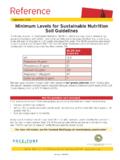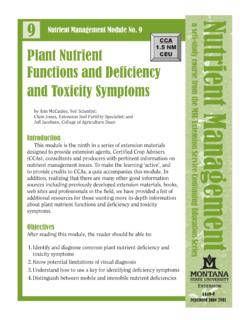Transcription of Organic Farming Technical Guide A farmer’s guide …
1 A farmer s Guide toOrganic fruitand vegetableproductionThe Organic Development Programme, run by Organic Centre Wales, is managed by the Welsh Assembly Government as part of Farming Farming Technical GuideTony Little, David Frost (editors)May 2008 Sponsored by:AcknowledgementsThe editors gratefully acknowledge the following:Contributors:Chris Creed, ADAS (Sections 3, 5, 9 and 11)David Frost, ADAS (Section 3)Roger Hitchings, Organic Research Centre Elm Farm (Sections 1 and 2)Tony Little, OCW (Sections 4, 7 and 10)Steven Turner (Section 8)Pauline van Diepen, ADAS (Section 6)Photographs:Cover: David Frost, Jeremy MooreInside: As creditedTranslationGwenllian RowlinsonFundingFarming ConnectTriodos BankPublished by Organic Centre Wales,Institute of Biological, Environmental and Rural Sciences,Aberystwyth University, Aberystwyth, Ceredigion, SY23 : 01970 622248 Organic Farming Technical Guide 3 Contents1.
2 Organic systems explained ..3 The principles of Organic Farming ..3 Characteristics of Organic Farming systems..3 The benefits of Organic Farming ..3 Organic horticulture ..32. Soil fertility ..5 What is soil fertility? ..5 How can you tell if a soil is fertile? ..5 Fertility and the Organic standards..5 The rotation ..5 The use of manures and other bulky Organic inputs..6 Composting ..7 Inorganic inputs..73. Pest, disease and weed control..8 Pests ..8 Diseases..8 Weeds ..94. Crop varieties ..11 Seeds, varieties and the Organic standards..11 The development and availability of Organic seed ..11 Choosing varieties ..115. Machinery and equipment.
3 126. Harvesting and storing ..13 Growing for storage ..13 Principles of good storage ..13 Types of store ..14 Economics of storage ..157. Energy and emissions..16 Food, fuel and greenhouse gasses ..16 The impact of climate change ..16 Adapting to a changing climate..17 Mitigating climate change ..178. Financial issues ..18 Supply and demand ..18 Profitability and gross margin calculations..189. Field vegetables..20 Soil conditions..20 Field growing systems..20 Propagation and crop establishment ..20 Crop husbandry and harvesting ..2110. Protected crops ..22 Why grow protected crops? ..22 Protective structures..22 Irrigation systems..23 Crops, rotations and fertility building strategies.
4 23 Pest disease and weed management ..2411. Top and soft fruit ..25 Top fruit ..25 Soft fruit ..2612. Further reading and references ..2813. Useful Contacts ..294 Organic Farming Technical GuideForewordRelatively few Welsh farmers have given serious thought to growing Organic fruit and vegetables. However, now is a good time to consider the possibility for a number of reasons including: strong demand for Organic horticultural products, while the supply base in Wales remains small; potential to significantly expand the volume and range of horticultural crops grown in Wales; a horticultural enterprise as an integral part of an existing livestock system may help to increase margins; the new Organic Farming Scheme, launched in November 2007, provides specific support for Organic horticulture ( 200/Ha/Year) for the first time.
5 Changes in CAP rules mean that as of May 2008, farmers will no longer lose the SPS entitlement on land down to horticultural Guide is aimed at farmers who are considering diversification into horticulture. It assumes a sound understanding of agricultural systems, but limited knowledge of fruit and vegetable a new enterprise is a significant step. As well as the opportunities, there are many challenges that need to be met such as Technical and production issues; marketing outlets, logistics and distribution; access to land, machinery, labour and hope that this Guide serves as a good introduction to Organic growing. We are fortunate in Wales to have a number of organisations who are able to help you put the theory into practice and these are listed at the back of this Centre Wales, May 2008 Organic Farming Technical Guide 51.
6 Organic systems The principles of Organic farmingOrganic Farming is underpinned by a set of guiding principles, drawn up by the International Federation of Organic Agricultural Movements (IFOAM). These are: the principle of health: Organic agriculture should sustain and enhance the health of soil, plant, animal and human as one and indivisible whole; the principle of ecology: Organic agriculture should be based on living ecological systems and cycles, work with them and help sustain them. Food production is itself a component of the local ecology. The more in tune the production process is with that ecology, the smaller the chance of serious problems arising; the principle of fairness: Organic agriculture should be built upon relationships that ensure fairness with regard to the common environment and life opportunities.
7 This principle recognizes human and social issues as well as environmental concerns; the principle of care: Agriculture should be managed in a precautionary and responsible manner to protect the health and well-being of current and future generations and the Characteristics of Organic Farming systemsOrganic Farming systems aim to put these principles into practice. They rely heavily on farm generated, renewable resources and less on external inputs. They are driven by ecological and biological processes to provide nutrition, and to protect against pests and main elements of an Organic system are: good soil management leading to good soil fertility, maintenance of high soil Organic matter, high levels of microbial activity and good soil structure; well designed crop rotations for balancing fertility, controlling weeds, and minimising pest and disease problems; preventative and non chemical approaches to weed, pest and disease problems; a profitable output of Organic cash crops and/or livestock.
8 All these aspects are discussed in detail later on in this The benefits of Organic farmingOrganic systems reduce the impact of the Farming system on the wider environment and contribute to the conservation of wildlife and natural habitats. Specific benefits include: increased biodiversity on farms and in the landscape at large; improved physical properties of soil; lower levels of soil erosion; reduced nitrate pollution; restriction of pesticide use; reduced emissions of ammonia, carbon dioxide and methane; reduced levels of controlled waste; increased energy efficiency; improved animal welfare; and enhanced water efficiency and improvements to water Organic horticultureHorticulture is a complex and varied sector.
9 The main types of production systems, and their key characteristics, are as follows:Intensive systems: fruit and vegetables only; high income - high cost systems; typically small market garden type holdings selling directly through local outlets such as farmers markets, local wholesalers and box schemes; very labour intensive; usually 3 years of crops with one or two years of fertility building; fertility breaks are cut and mulched. Crops must be high value to compensate for the lack of income from the fertility Organic Farming Technical GuideField scale vegetables: vegetables only; large volumes of a relatively small range of crops; typical outlets are either pre-packers for supermarket sales or larger box schemes; high degree of mechanisation; economies of scale mean relatively low production costs but prices are also generally lower and quality requirements are often vegetable rotations: similar scale to field vegetables, also with a high degree of mechanisation; usually one vegetable crop in the rotation which acts as a break crop and helps to bring in additional income.
10 Can operate on heavier soils than field vegetables alone;Mixed rotations: feature livestock and a range of crops ( vegetable , arable and fodder); fertility building breaks are much longer and are grazed by stock to produce meat or milk; vegetable crops can be grown on poorer soils as a fertility break restores structural damage from the cultivations; animal manures are readily available; vegetables can be incorporated as one or two field-scale crops within the arable rotation. Alternatively, a wider range of vegetables can be grown within a single rotation break, a situation more akin to an intensive cropping enterprise within a relatively extensive mixed Farming system;Perennial cropping systems: mainly fruit production but can include some vegetables asparagus, globe artichokes and rhubarb; mostly woody perennials such as trees (top fruit ) and bushes (soft fruit ); crops stay in the same place year on year, so that rotations cannot be applied.







